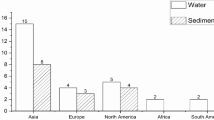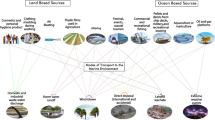Abstract
The sedimentary distributions of radiocesium and plutonium have been used to determine patterns of fine-particle accumulation, estimate net sediment fluxes from different sources, and develop a fine-particle budget for the Hudson-Raritan estuary. It is proposed that the rates and patterns of fineparticle accumulation reflect a sediment surface in dynamic equilibrium with the wave and current regimes. Rates of accumulation in most estuarine areas appear to equal the rate to sea-level rise or land subsidence. Localized areas, which have not yet attained or are presently out of equilibrium, serve as fine particle traps.
Similar content being viewed by others
References
Postma H (1967) Sediment transport and sedimentation in the estuarine environment. In: Lauff GH (ed) Estuaries. American Association Advancement Science, Washington D.C. pp 158–179
Meade RH (1969) Landward transport of bottom sediments in estuaries of the Atlantic coastal plain. Journal of Sedimentary Petrology 39:222–234
Conomos TJ, Peterson DH (1976) Suspended particle transport and circulation in San Francisco Bay: an overview. In: Wiley M (ed) Estuarine Processes II. Academic, New York pp 82–97
Olsen CR, Simpson HJ, Bopp RF, Williams SC, Peng T-H, Deck BL (1978) Geochemical analysis of the sediments and sedimentation in the Hudson estuary. Journal of Sedimentary Petrology 48:401–418
Biggs RB (1970) Sources and distribution of suspended sediment in Northern Chesapeake Bay. Marine Geology 9:187–201
Schubel JR, Carter HH (1976) Suspended sediment budget for Chesapeake Bay. In: Wiley M (ed) Estuarine Processes II. Academic, New York pp 48–62
Olsen CR (1979) Radionuclides, Sedimentation, and the Accumulation of Pollutants in the Hudson Estuary. Doctrate in Philosophy Thesis, Columbia University, New York
Olsen CR, Simpson HJ, Peng T-H, Bopp RF, Trier RM (1981) Sediment mixing and accumulation rate effects on radionuclide depth profiles in Hudson estuary sediments. Journal of Geophysical Research 86:11020–11028
Simpson HJ, Olsen CR, Trier RM, Williams SC (1976) Man-made radionuclides and sedimentation in the Hudson River estuary. Science 194:179–183
Bopp RF, Simpson HJ, Olsen CR, Trier RM, Kostyk N (1982) Chlorinated hydrocarbons and radionuclide chronologies in sediments of the Hudson River and estuary, New York. Environmental Science Technology 16:666–676
Olsen CR, Larsen IL, Brewster RH, Cutshall NH, Bopp RF, Simpson HJ (1984) A Geochemical Assessment of Sedimentation and Contaminant Distributions in the Hudson-Raritan Estuary. NOAA Technical Report NOS OMS 2. U.S. Department of Commerce, Rockville, MD
Ellsworth J (1982) Shore erosion as a source of fine-grained sediment in the lower Hudson River. Master of Science Thesis, State University of New York, Stony Brook, NY
United States Geological Survey (1977) Water Resources Data for New York, Water Year 1977. U.S. Geological Survey Water Data Report NY-77-1
Author information
Authors and Affiliations
Rights and permissions
About this article
Cite this article
Olsen, C.R., Cutshall, N.H., Larsen, I.L. et al. An estuarine fine-particle budget determined from radionuclide tracers. Geo-Marine Letters 4, 157–160 (1984). https://doi.org/10.1007/BF02281698
Received:
Revised:
Issue Date:
DOI: https://doi.org/10.1007/BF02281698




